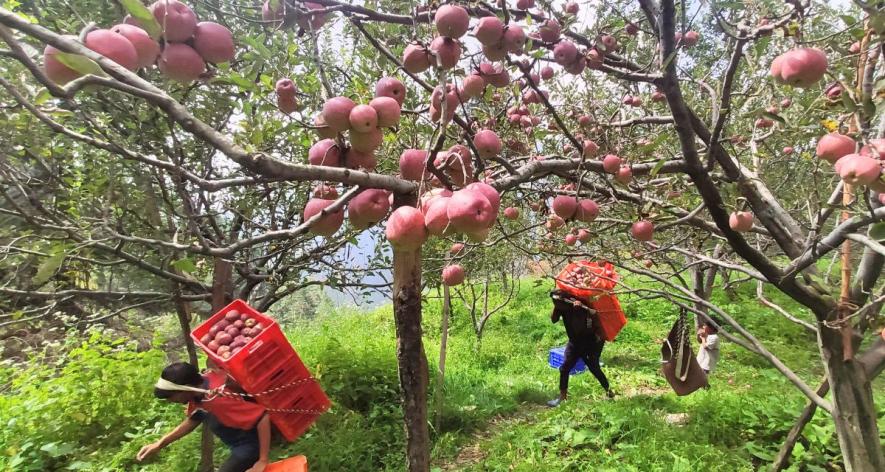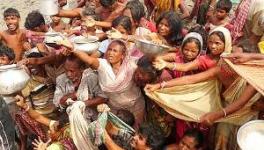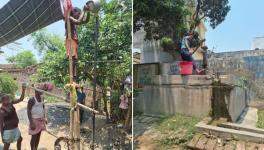Climate Change Upsets the Apple Cart of Orchardists in Himachal Pradesh

Shimla, Himachal Pradesh: "Climate change and the resultant warm winters have been seriously impacting our apple crop's productivity and quality. Over the last two to three decades, production has gradually come down by about 30%. The lifespan of traditional varieties of apple [Mollies, Gala, Anna and Golden] trees has reduced," attested Chatter Singh Kalet (64), an orchardist from Madavag in Chopal sub-division of Shimla district, while listing out the problems inflicting the Rs 6,000-crore apple economy of Himachal Pradesh.
HP Samyukta Kisan Manch co-convener Sanjay Chauhan (56) told 101Reporters that over four lakh families are associated with apple farming, contributing around 13% to the Gross Domestic Product of the hill state.
"However, less or no snowfall between December and February and untimely rains and hailstorms during the flowering or fruit-setting period from March to June have triggered a fall in production."
Sujat Chauhan (43), an apple grower from Theog, said less snowfall this year means apple trees will not get the required chilling hours.
"This hurts us more as we will have to shell out extra bucks to buy pesticides to reduce the impact of ecosystem imbalance in the form of pest attacks and diseases."
"Around three years ago, a 50-kg bag of fertiliser cost Rs 800 to 1,100. However, the same bag now costs Rs 1,500 to 2,000. This means the price has been increasing by almost 30% year after year. Pesticide prices have soared from Rs 400-500 to Rs 800-900 per drum," Sujat detailed.
Not just winters, the monsoon season has also left the apple economy in tatters. Persistent and untimely spells of rain and hailstorms from March-April to June have led to widespread losses in Shimla, Mandi, Sirmaur, Kullu, Chamba and Kinnaur districts.
A horticulture development officer, on condition of anonymity, pegged the total number of horticulture farmers affected in Shimla, Kullu and Mandi districts at 59,338.
"The total losses are worth Rs 162 crore, while the total area affected in the rains is 25,237 hectares. The government only grants compensation to farmers who have suffered losses above 33%," he informed.
According to the state government data (June 24 to October 2), apple crops in 808 hectares in Shimla district and 475 hectares in Mandi district were affected by monsoon fury. State Horticulture Minister Jagat Singh Negi told 101Reporters that apple crops suffered extensive damage in heavy rains, thus bringing down the production by half this year as compared to the previous year.
The Faceless Villain
The highest-ever production figure of 5.11 crore boxes of apples in Himachal Pradesh was registered in 2010, but since then, it has never crossed that mark. The lowest production was in 2018, as the state produced only 1.65 crore boxes. From this season onwards, the Himachal Pradesh government has decided that apples will be sold on the basis of kg and not boxes.
Each box carries 20 to 22 kg of apples. However, farmers used to make very little money from the market. The per-box system fleeced them as only fixed rates were offered to them. By selling a box of low-quality apples at a per kg rate this season, a farmer could make Rs 1,200 to 1,400. When the box system was in place, the same box could fetch only Rs 700 to Rs 1,000.
The impacts of climate change on apple production are highlighted in a 2020 study.
"There is an average increase in temperature of about 1.5 degree Celsius till October, whereas a 2-10% reduction in rainfall and 50-100 ppm increase in CO2 concentration have been observed, which reduce the apple yield."
The study noted that climate change led to the shifting of apple belt in hilly regions of Himachal Pradesh to places situated in even higher altitudes such as Kullu, Kinnaur, Lahaul and Spiti, Sirmaur district's Rajgarh area, Shimla district's Theog and Kotkhai and some areas in Solan district. It also highlighted that the population of pollinators such as honeybees and butterflies has declined due to high temperatures at higher hills, thus impacting apple production.
It said in Himachal Pradesh, there is a loss in yield by 40 to 50% due to increased temperature and reduced chilling hours. The chilling period/requirement is the minimum period of cold weather required to resume the normal spring growth of an apple tree following the winter period.
"In apples, there is a decrease in yield due to water shortage (80%) and evaporation rate (20%), leading to a reduction in chilling hours. This causes shifting of apple belts towards higher hills of Himachal Pradesh as most cultivators require 1,000 to 1,600 chilling hours at or below seven degrees Celsius," the study detailed.
At lower elevations, apple cultivation has been affected, and large areas have been deemed unfit for the crop. Climate change has also affected the quality of the fruits as too much heat messes up their colour.
A 2011 study on the impact of climate change on apple crops in Himachal stressed that daily temperatures of 70°F and higher for four or more hours received by the tree during the previous 24 to 36 hours can actually negate chilling.
"Apple and stone fruit trees develop their vegetative and fruiting buds in the summer, and as winter approaches, the already developed buds go dormant in response to both shorter day lengths and cooler temperatures," said the study.
The buds remain dormant until they have accumulated sufficient chilling units of cold weather. If the buds do not receive sufficient chilling temperatures, trees will develop delayed foliation, reduced fruit set, increased buttoning and reduced fruit quality.
"We have almost reached the threshold of the climate change situation this year. The change in temperatures from February to June period calls for a rejuvenation plan for orchards by providing new planting material or subsidies to shift to high-density cropping," Sanjay Chauhan said.
Sujat Chauhan said persistent rains at the time of flowering caused a drop in temperatures while the trees at that time required sunny weather with 15 degree Celsius or higher temperature. "This badly affected pollination and fruit-setting, resulting in apple production falling by 40 to 50% this year."
Rising Pest Attacks
Warmer winters are also leading to various diseases in apple trees. Sujat said farmers were witnessing higher incidences of Scab, Alternaria (leaf and fruit) and even mite attacks now than in the past.
Echoing such concerns, SK Bhardwaj, Head of Environment Science Department, Dr YS Parmar University of Horticulture and Forestry at Nauni in Solan district, told 101Reporters that the lack of favourable weather conditions calls for crop diversification. "Farmers should also focus on pulses, vegetables or livestock farming while going for high-density apple varieties that can withstand climatic challenges," he said.
Livestock rearing and cultivation of pulses, fruits, and vegetables can supplement the income of orchardists as they can better deal with adverse weather conditions. Further, these can be managed by farmers themselves, unlike in the case of apples, where labourers need to be employed for the upkeep of orchards.
The situation in Himachal Pradesh, popularly known as the 'Fruit Bowl of India', is a wake-up call for the government, agri-horticulture universities and farmers to gear up to deal with climatic challenges. Horticulture Minister Negi said the department was urging farmers to go for high-density apple cultivation through new rootstock varieties to sustain challenges posed by global warming. He also exhorted farmers to join the Weather Based Crop Insurance Scheme to cover their losses in case of adverse weather conditions.
Royal Delicious, Red Delicious, Richared, Golden Delicious, Red Golden, Red Chief, Vance, Oregon Spur and Super Chief are among the high-density apple varieties. Against the 250 to 300 apple trees that can be accommodated in a plot measuring one hectare, 2,000 to 3,000 high-density trees can be grown in the same plot. These varieties give higher yields than traditional varieties, though the initial input costs on irrigation systems, plantation and nets are high.
The farmers have been getting their insurance claims, but the process is a bit lengthy and cumbersome for them. Meanwhile, Sandeep Kumar Sharma, a scientist at Meteorological Centre, Shimla, said the long-range forecast for Himachal Pradesh has predicted normal to above-normal precipitation in the ongoing winter season.
(Sanjeev Kumar is a Himachal Pradesh-based freelance journalist and a member of 101Reporters, a pan-India network of grassroots reporters.)
Get the latest reports & analysis with people's perspective on Protests, movements & deep analytical videos, discussions of the current affairs in your Telegram app. Subscribe to NewsClick's Telegram channel & get Real-Time updates on stories, as they get published on our website.























